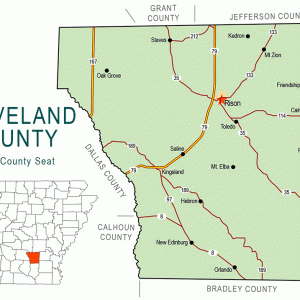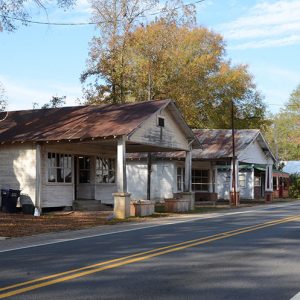calsfoundation@cals.org
New Edinburg (Cleveland County)
Located on Highway 8 between Warren (Bradley County) and Fordyce (Dallas County) is the town of New Edinburg. Before 1873, it was located in Bradley County. In 1873, Bradley County was divided, and New Edinburg landed in Dorsey County (later renamed Cleveland County). The New Edinburg Commercial Historic District is listed on the National Register of Historic Places.
Native American tribes likely traveled through the area and may have settled along the banks of the Saline River. Many artifacts have been found to support this.
Several white families settled in the area in the 1830s. These first families—Marks, Smith, Davis, Crain, Washburn, McDaniel, and Hudson—were wealthy, possessed many slaves, and were well educated. By the 1840s, a group of businessmen met at L’Aigle Creek, known as Eagle Creek, and purchased land for a town. This first property was located east of present-day New Edinburg. The town was called Washburn Flats prior to its organization.
A log church called the Free House Church was built in 1838 by William Walker. So that slaves and slave owners could attend services at the same time, the two groups were separated by a slight partition.
On April 25, 1864, the Action at Marks’ Mills was fought on Marks family land, with the John Harvie Marks home used as a temporary hospital. This home was located about a mile from the battle. Through the years, artifacts such as mini-balls, cannonball fragments, spurs, bullets, and buckles have been found in the area.
The first home in present-day New Edinburg was built by Dr. Egbert Moses in 1859. Several other doctors made their homes in New Edinburg. A popular midwife, Mary H. McCullough, also practiced in the area.
New Edinburg was initially dubbed Edinburg, with a post office under that name beginning in 1876; John Fowler was the first postmaster. By 1891, the town had been renamed New Edinburg, as suggested by John H. Cherry. At that time, there were two churches, a livery, several mercantile stores, grist mills, gins, and blacksmiths. The Saline River Railroad, which passed through the town, was chartered in 1897 and was running by 1898; it was a spur of the St. Louis, Arkansas and Texas Railway (commonly called the Cotton Belt).
In 1904, the Bank of New Edinburg was organized, with E. M. Attwood as the founder and president. During the Great Depression, it was the only bank in the county that remained open. By 1936, there were several merchants in New Edinburg, as well as cafes and a beauty shop. One building housed both the Central Telephone Office and the Knight Theater, which showed matinees at noon for children on their lunch break from school and also had shows after school and on Saturday nights.
New Edinburg was known for having a tree in the middle of the road, which traffic had to go around. The tree had to be cut down when the road was paved and became a state highway in July 1940.
Education
The first educational building was built by the Masons. In 1886, a new school building was erected. In 1903, land for a school was donated by W. D. Attwood. (A vacant school building sits on that lot in the twenty-first century.) In 1931, most of the smaller schools in the area consolidated into the New Edinburg School District. In 1985, the district was consolidated into the Cleveland County School District. The town declined with the consolidation of the schools, and the population decreased.
Attractions
Built by the Clements family around 1879, the Clements Hotel has a long history in New Edinburg. Early pictures of the hotel show a two-story building with a front porch and a grand balcony on the second floor. The hotel was sold to the John Stewart family and became a single-family home for a time. The last resident of the house was Mattie Stewart Sloane. As time passed, the structure became overgrown with vegetation and was rotting away. The house was purchased by Willie Carroll Livingston in 2006 and has been restored to what it was when the Stewart family lived there. Although it is unoccupied, the Livingstons have hosted several parties there with live music on the front porch.
The Marks’ Mills Battleground State Park and the Marks Cemetery are located a few miles outside of New Edinburg. Visitors may tour these sites.
Famous Residents
Elisha Lawley McMurtrey was a lieutenant colonel in the Confederate army during the Civil War. He was involved in twenty-two battles and was elected to the Arkansas General Assembly in 1878. Kermit C. Moss served in World War II and received two bronze stars; he was also one of the guards for Madame Chiang Kai-shek. Paul “Bear” Bryant, the legendary University of Alabama football coach, was born and raised a few miles from New Edinburg.
As of 2010, New Edinburg, a census-designated place (CDP) had a population of 127. It is mostly a farming community, with a Baptist and a Methodist church within town limits, as well as a country store. Most people who live in New Edinburg travel to other cities for employment.
For additional information:
Cleveland County, Arkansas: Our History and Heritage. Rison, AR: Cleveland County Historical and Genealogical Society, 2006.
Cleveland County Potpourri: Recollections from History and Folklore. N.p.: Cleveland County Schools and the Cleveland County Bicentennial Commission, 1976.
Ledbetter, Richard. “New Edinburg, an Ode to Quaintness.” Pine Bluff Commercial, May 14, 2024, pp. 1, 4. Online at https://www.pbcommercial.com/news/2024/may/14/new-edinburg-an-ode-to-quaintness/ (accessed May 14, 2024).
Paula Reaves
New Edinburg, Arkansas
 Cleveland County Map
Cleveland County Map  New Edinburg Commercial Historic District
New Edinburg Commercial Historic District 



Comments
No comments on this entry yet.